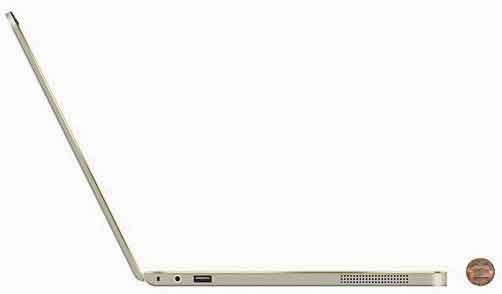Thin is cool. Thin is sexy. Thin is chic. The thinner, the
better.
Thin is cool. Thin is sexy. Thin is chic. The thinner, the better.
If I were talking about us, about people, that whole “our bodies, ourselves” kind of thing, then I would be shouted down, pilloried as a dangerous disseminator of a wrong-headed and hurtful bias that has distorted our society’s definition of beauty and driven countless young women and men into eating disorders in pursuit of an impossible ideal.
But relax. I’m talking about our electronic gadgets, where the pursuit of absolute, ultimate thinness is not only acceptable, it’s celebrated.
When it comes to the cutting edge of cool in televisions, cell phones or laptops, thin is in. So much so that when Apple recently released its latest-greatest laptop, the chief selling point, the feature that distinguishes it from its competitors, is that it is the world’s thinnest laptop computer.
It’s not necessarily faster, smarter or more powerful. It’s just really, really thin. Its beauty, both as next-step technology and status-symbol object, is all on its wafer-thin surface, with an all-but-weightless word for a name: Air, as in lighter-than.
It might be a stretch to say that there’s a conflict here, but at the very least, there are some striking parallels bouncing back and forth between the ways we think of thin when it comes to us and when it comes to our high-tech toys.
Now, it’s easy to point out, and without sounding even the teensiest bit defensive, that there are abundant reasons why we as users value thinness in our electronic gadgets. Thin means light, thin means compact. Thin means your cell phone slips easily into a pocket or your laptop into your briefcase. It means your TV hangs on your wall instead of swallowing up half your media room.
“I’m a road warrior,” says Keith Whitman, 31, outside of an Apple store in Dallas. “I’m on the road three weeks out of every month. I got an Air two days after they were released. Thin and light make a big difference.”
So there you are. It’s all about practicality, not aesthetics, function not form. Or is it? A moment later, his gaze fixes on its sleek, brushed silver, super-slim case and he adds, “It doesn’t hurt that it’s the coolest looking laptop I’ve ever owned.”
It’s not coincidental that Apple, the company that has wrapped its better-mousetrap product in the future-is-now chic of its packaging, is leading the thinner-thinnest charge. Function may address the rational demands we have for our technology, but form is there to meet our emotional demands. As users, we want gadgets that are convenient; as consumers we want gadgets that are cool. And when it comes to us and our technology, cool means thin. And we’re willing to pay for it – at $1,800 for the lesser Air model, Apple’s new state-of-the-art slim, weighing in at three pounds, costs $37.50 an ounce.
I don’t want to say we’re obsessed with the thinness of our techno-toys, so I’ll let someone else do it.
“Oh yeah, it’s an obsession,” says Robert Pederman, president and CEO of Zagg Inc., a company specializing in products for the thin-techno-toy crowd. “Just look at how much money people spend to get the newest, coolest phones and laptops.
Pedersen’s company makes the InvisibleShield, a coating made of the same high-tech material the military uses to protect blades of its helicopters. It’s super-strong and completely transparent. Just slip it on your sleek phone or your thin computer, and it is safe from dings, nicks and scratches. Even better, you (and everyone else) can still see all its subtle curves and chic lines. Its thinness isn’t hidden under some clumsy, bulgy, non-thin armor.
Think of it as lingerie for your cell phone.
“Companies spend all this money designing these sexy, sleek products and people spend all this money to buy them, and then they have to cover them up in some big, bulky, burlap sack of rubber or silicon to protect it,” he said. Introducing InvisibleShield at the Macworld convention last year, the company had a sign that said, “Go Naked,” and wore T-shirts that said, “Get naked gadgets” on the front and “the way nature intended” on the back.
That “thin is sexy” feeling is a part of the emotional side of attraction to thin technology. But maybe, in such a dynamic field, built on revolution and rapid change, our old ideas about what thin means are evolving, morphing into something new and, dare I say it, expanded.
“We’re thinking of ThinkPad X300 as a different kind of thin, as a thin with no compromises,” says Tom Ribble, a development director with Lenovo, speaking of the computer maker’s new notebook computer. “It’s thin and very light, but it still delivers a tremendous amount of performance.”
All this “thinnovation” (a term currently being heralded by – who else? – Apple) could be pushing toward a new kind of thin.
“I think we’re turning the corner on thin,” says Dr. Robbie Blinkoff, a consumer anthropologist and managing director of Context-Based Research Group. “People are slowly coming up with new ways of thinking about thin.
“It’s about `thinning out’ all the unnecessary technology you carry around. It’s about just bringing the essentials along. Our culture right now is about getting rid of excess baggage.”
That sounds pretty good, optimistic even.
But then you remember that all this thinnovation is happening amid headlines of America’s obesity epidemic and stories about the trend in ultra-thin models and celebrities and the inevitable reports of teenagers devastated by eating disorders.
That tends to tarnish the silver lining – not only are we obsessed with being thin, now we’re obsessed with buying thin.
“All these campaigns touting all these thin gadgets do highlight the pervasiveness of it,” says Dr. Kimberly Dennis, an associate medical director for Timberline Knolls, a national treatment center in Chicago for women with eating and other emotional disorders.
“The crossover of technology with our obsession with being thin is especially interesting since in so many ways technology gives us distance, ways to avoid face-to-face interaction,” she says. “And when you get down to it with eating disorders or, really, any addiction, they are diseases of isolation.”
Whew. Those observations are getting awfully big and bulky. Let’s just go back to the light and easy thought that thin gadgets fit in your pocket. There. That’s better.















